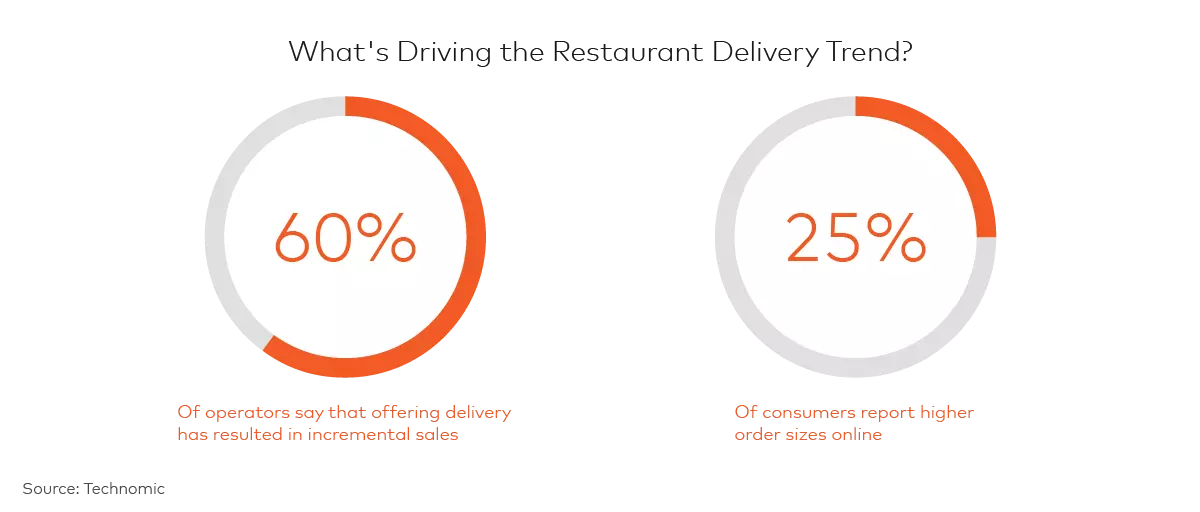More and more restaurants are offering consumers delivery services. Find out what's driving this restaurant delivery trend, and how to come out ahead.
Food delivery has exploded in recent years. Fueled by growth in digital and mobile channels, it is predicted to grow 12% each year over the next five years and shows no signs of stopping.
However, opinions on the growing trend are mixed. On the one hand, 60% of operators say that offering delivery has resulted in incremental sales, and 25% of consumers report higher order sizes online. Yet on the other hand, the high costs of third-party delivery (typically 20-30% of order sales) and concerns over the customer experience are causing some to take delivery into their own hands or even stay out of the channel altogether.
While, on paper, there's a clear opportunity for restaurant operators to grow their businesses through delivery services, success will ultimately be highly dependent on the restaurant, the concept and the execution.
Delivery Options Abound
For restaurants such as Famous Dave's, working with a variety of aggregators has seen average checks jump from $17 in-store to $27 for delivery, bringing in incremental revenue while broadening their reach. Due to the success of their partnerships, others — such as Jersey Mike's — are further capitalizing on the trend by integrating delivery services into their POS systems and running promotions through their partners.
Alternatively, Sweetgreen is streamlining delivery in-house with its "Outpost" system, delivering multiple orders throughout the day to specified locations within established organizations. Doing so has allowed Sweetgreen to capture the entirety of its delivery orders while providing a better customer experience, with deliveries made for free in less than 15 minutes.
As restaurants shift gears to not only engage in but also excel in delivery, it's crucial that they take a data-driven approach. Leading restaurants are testing to identify where to prioritize delivery rollout, how many and with which aggregators to partner (if any!), how to optimize delivery menus and pricing, and how best to drive incremental sales and traffic through promotions.
The Future of Delivery
With online food delivery projected to be a $365 billion industry by 2030, difficult economics and intense competition will force restaurants to continuously innovate in the space. As younger generations fueling the growth of delivery grow in purchasing power, emerging technologies such as Eatsa's modular Spotlight Pickup shelf and Wayback's kitchen-on-wheels will be at the forefront of streamlining service and delivering better guest experiences. Moreover, the addition of ghost kitchens and robot chefs, such as Zume Pizza's robot workforce, can bring unit costs down by as much as 50% as they become more widely adopted.
Restaurants won't be the only ones innovating, however. Pushback from restaurant operators on the costs of using third-party delivery services is causing some, such as Uber Eats, to refocus on helping operators grow sales and margin. Last year, the service began promoting local "Specials" in India that allowed restaurants to bundle products together at a discounted price. While the bundle could attract incremental traffic, restaurants could also include high-margin products to boost profit with each sale.
As the delivery landscape continues to evolve and both in-house and third-party services mature, restaurants should continuously analyze market-, site- and customer-level insights to navigate the changes and innovations on the horizon. By taking an outside-the-four-walls view of market trends across channels, restaurant brands can identify the greatest headroom opportunities to rapidly test and refine delivery strategies. Doing so will be the key to leveraging delivery to drive incremental sales, acquire new customers and build loyalty in existing ones.
Ask Dean de la Pena
Questions on this article? Reach out to Dean de la Pena to learn more about the restaurant delivery trend.









